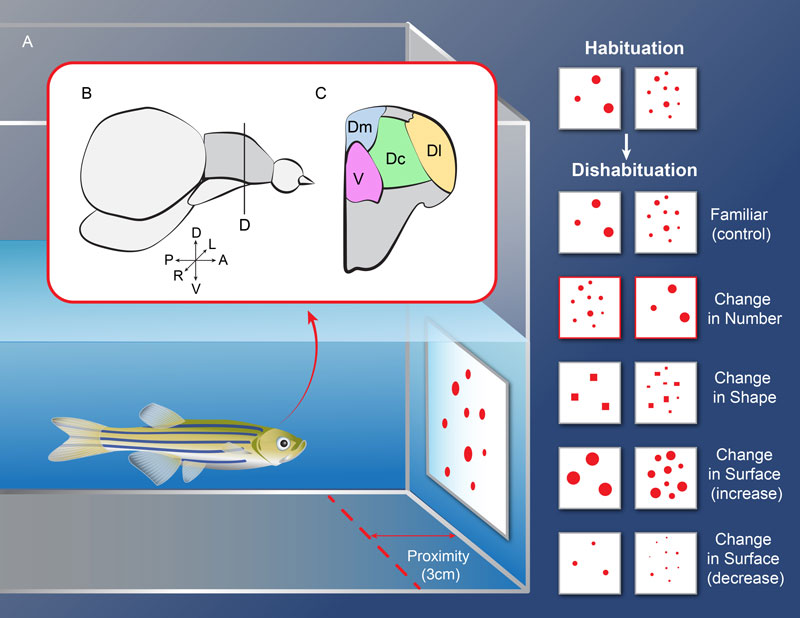What underlies the ability to count and where did it come from? One hypothesis is that our ability to accurately represent the number of objects in a set (numerosity), and to carry out numerical comparisons and simple arithmetic, developed from an evolutionarily conserved system for approximating numerical magnitude. Its genetic basis is revealed by the small fraction of people with the inability to judge number or make simple calculations; its localization to specific subregions of the brain has been suggested from functional studies of the human brain. According to this hypothesis, the ability to assess numerosities would have a conserved genetic and neural basis.

Figure: A) The set up and stimuli used for the habituation and dishabituation phases in zebrafish experiments. Inset B) Scheme of the lateral view of zebrafish telencephalon with C) a cross-section of telencephalic nuclei tested for molecular biology analyses. Dc: dorsal-central; Dl: dorsal-lateral; Dm: dorsal-medial; V: subpallium.
To test this proposed conservation of numerosity, we turned to an evolutionarily distant vertebrate species, the zebrafish, which has become a prominent model for genetics and cell biology research. Our long term goals are to define the regions of the brain that respond to numerosity, to determine if there is a functional “map” of numerosity in the brain, and to define some of the key genes required for a functioning sense of numerosity. To date, our studies reveal that neurons in a restricted region of the pallium change their activity in response to changes in the number of visual items.
Test experiments are challenging in experimental animals that lack language skills, so we used novelty as a way to reveal an animal’s ability to perceive a stimulus, an approach that has been fruitful in studying human newborn infants. Zebrafish were first habituated to sets of small dots that changed in individual size, position and density while maintaining their numerousness and overall surface area. At test, zebrafish were presented with a change in number (with the same overall surface), in shape (with the same overall surface and number), or in size (with the same shape and number) of the dots. To score which of these changes were perceived as novel, hence different, the expression of some immediate early genes were used to score neural activity. Staining the brains revealed a selective activation of the caudal part of the dorso-central division of the zebrafish pallium upon change in numerosity. This region of the fish brain is homologous to the regions of the human brain involved in the formation of memories and the processing of emotional states.
This finding supports the existence of an evolutionarily conserved mechanism for approximating magnitude and provides an avenue to understanding its underlying molecular correlates.
The HFSP funding was instrumental in developing our collaboration, which comprises specialists in disparate areas such as molecular genetics, behavior and advanced imaging techniques.
|
HFSP award information Research Grant - Program (RGP0008/2017): Imaging the neurobiology of numerosity - the evolution of counting Principal investigator: Caroline Brennan, Queen Mary University of London, UK |


































